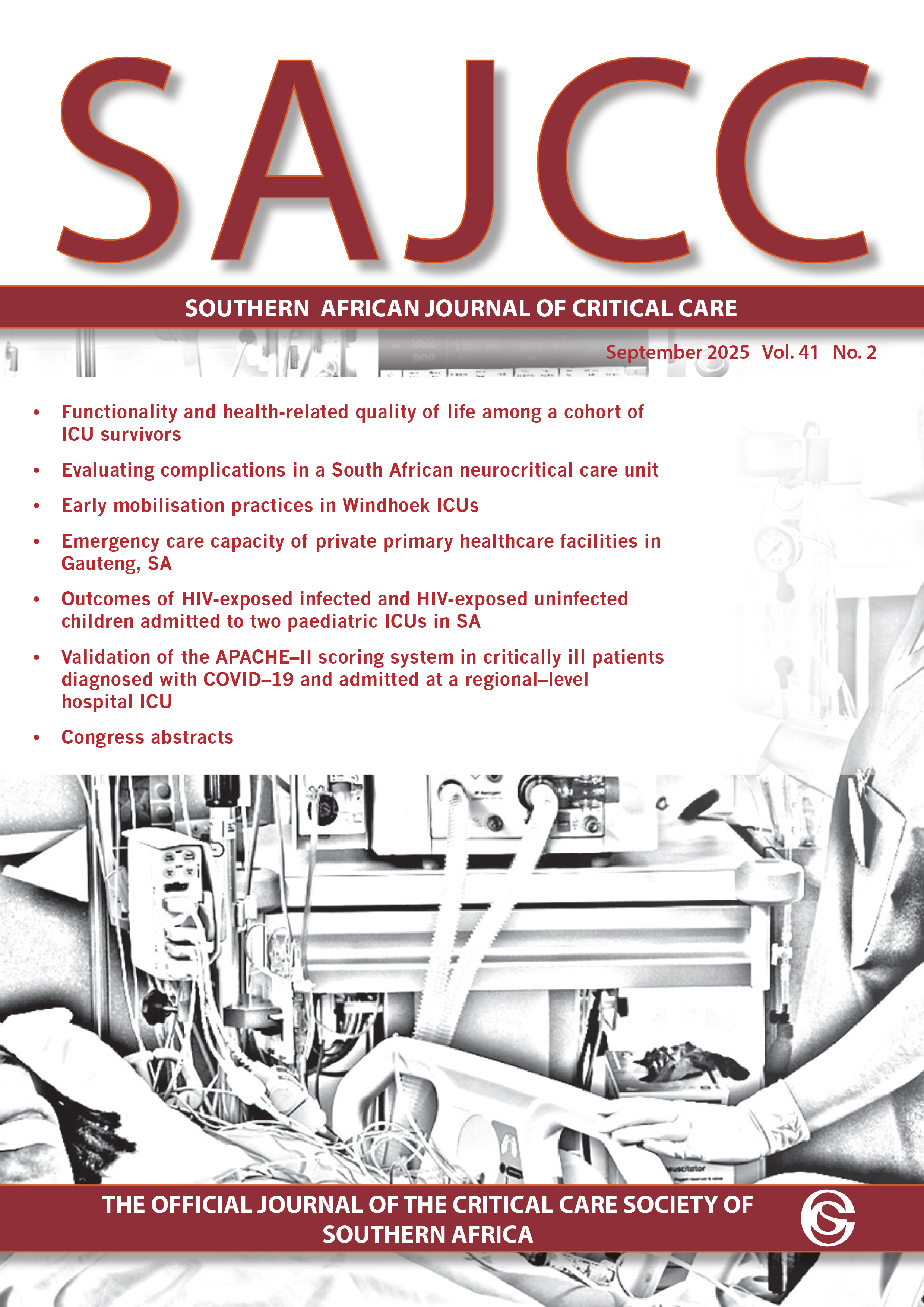Evaluating complications in a South African neurocritical care unit: A 1-year retrospective audit
Main Article Content
Abstract
Background. The benefits of setting up a dedicated neurocritical care unit (NCCU) for critically ill neurological patients are well documented. These units are specifically designed to care for individuals with conditions affecting the brain and spine. However, complications particular to these units in low- and middle-income countries are not widely reported.
Objectives. To describe the complications observed in an NCCU at a tertiary-level academic hospital over the course of 1 year and examine their link with intensive care unit (ICU) length of stay (LOS) and mortality rates.
Methods. The study involved retrospective analysis of complications experienced by critically ill neurological patients admitted to the NCCU between 1 January and 31 December 2020, according to the NCCU patient data registry.
Results. A total of 850 patients, most of whom were male (61.2% in the high-care unit (HCU) and 68.1% in the ICU), were admitted to the NCCU, with a median age of 43 years and 41 years in the HCU and the ICU, respectively. The overall rate of complications was 38.2% (n=325/850 patients). Statistically significant complications (p<0.05) included metabolic and electrolyte imbalances, infections (including ventilator-associated pneumonia, surgical site infections and central line-associated bloodstream infections), and deep-vein thrombosis. The most common complication was metabolic disturbances (28.2%), particularly sodium homoeostasis abnormalities. The number of complications significantly affected NCCU LOS (p<0.001), but did not have a statistically significant impact on mortality (p=0.067).
Conclusion. Complications occurred in 38.2% of critically ill neurological patients in a specialised NCCU in a tertiary-level academic hospital in South Africa, primarily involving electrolyte disturbances and infections. These complications were linked to longer LOS in the ICU, but did not significantly increase the risk of mortality.
Article Details
Issue
Section

This work is licensed under a Creative Commons Attribution-NonCommercial 4.0 International License.
The SAJCC is published under an Attribution-Non Commercial International Creative Commons Attribution (CC-BY-NC 4.0) License. Under this license, authors agree to make articles available to users, without permission or fees, for any lawful, non-commercial purpose. Users may read, copy, or re-use published content as long as the author and original place of publication are properly cited.
Exceptions to this license model is allowed for UKRI and research funded by organisations requiring that research be published open-access without embargo, under a CC-BY licence. As per the journals archiving policy, authors are permitted to self-archive the author-accepted manuscript (AAM) in a repository.
How to Cite
References
1. Kurtz P, Fitts V, Sumer Z, et al. How does care differ for neurological patients admitted to a neuro- ICU versus a general ICU? The Greater New York Hospital Association ICU Prevalence Survey. Crit Care 2008;12(2):P497. https://doi.org/10.1186/cc6718
2. Suarez JI, Zaidat OO, Suri MF, et al. Length of stay and mortality in neurocritically ill patients: Impact of a specialized neurocritical care team. Crit Care Med 2004;32(11):2311-2317. https://doi. org/10.1097/01.ccm.0000146132.29042.4c
3. Jeong JH, Bang JS, Jeong WJ, et al. A dedicated neurological intensive care unit offers improved outcomes for patients with brain and spine injuries. J Intensive Care Med 2019;34(2):104-108. https://doi.org/10.1177/0885066617706675
4. Soliman I, Aletreby WT, Faqihi F, et al. Improved outcomes following the establishment of a neurocritical care unit in Saudi Arabia. Crit Care Res Pract 2018;2018:2764907. https://doi. org/10.1155/2018/2764907
5. Rubinos C, Ruland S. Neurologic complications in the intensive care unit. Curr Neurol Neurosci Rep 2016;16(6):57. https://doi.org/10.1007/s11910-016-0651-8
6. Venkatasubba Rao CP, Suarez JI, Martin RH, et al. Global survey of outcomes of neurocritical care patients: Analysis of the PRINCE study part 2. Neurocrit Care 2020;32(1):88-103. https:// doi.org/10.1007/s12028-019-00835-z
7. Santafé Colomina M, Arikan Abelló F, Sánchez Corral A, Ferrer Roca R. Optimization of the neurosurgical patient in intensive care. Med Intensiva (Engl Ed) 2019;43(8):489-496. https://doi. org/10.1016/j.medin.2019.02.011
8. Prin M, Li G. Complications and in-hospital mortality in trauma patients treated in intensive care units in the United States, 2013. Inj Epidemiol 2016;3(1):18. https://doi.org/10.1186/s40621- 016-0084-5
9. Gounder M, Hardcastle TC, Muckart DJJ. A review of the complications encountered in a quaternary trauma intensive care unit in South Africa. S Afr J Surg 2019;57(1):43-48. https://doi. org/10.17159/2078-5151/2019/v57n1a2733
10. Deveduthras N, Balakrishna Y, Muckart D, Harrichandparsad R, Hardcastle T. The prevalence of sodium abnormalities in moderate to severe traumatic brain injury patients in a level 1 trauma unit in Durban. S Afr J Surg 2019;57(2):62-67. https://doi.org/10.17159/2078-5151/2019/ v57n2a2823
11. Papazian L, Klompas M, Luyt CE. Ventilator-associated pneumonia in adults: A narrative review. Intensive Care Med 2020;46(5):888-906. https://doi.org/10.1007/s00134-020-05980-0
12. Van der Merwe E, Baker D, Sharp G, van Niekerk M, Paruk F. Long-stay medical-surgical intensive care unit patients in South Africa: Quality of life and mortality 1 year after discharge. S Afr Med J 2022;112(3):227-233. https://doi.org/10.7196/SAMJ.2022.v112i3.16191
13. Kılıç M, Yüzkat N, Soyalp C, Gülhaş N. Cost analysis on intensive care unit costs based on the length of stay. Turk J Anaesthesiol Reanim 2019;47(2):142-145. https://doi.org/10.5152/ TJAR.2019.80445
14. Jiang J, Upfill-Brown A, Dann AM, et al. Association of hospital length of stay and complications with readmission after open pancreaticoduodenectomy. JAMA Surg 2019;154(1):88-90. https:// doi.org/10.1001/jamasurg.2018.3213
15. Peden MM, Scurfield R, Sleet D, et al., eds. World report on road traffic injury prevention. Geneva: World Health Organization, 2004. https://www.who.int/publications/i/item/world- report-on-road-traffic-injury-prevention (accessed 10 May 2022).
16. Moodley NB, Clarke D, Aldous C. An audit of trauma-related mortality in a provincial capital in South Africa. S Afr J Surg 2014;52(4):101-104. https://doi.org/10.7196/sajs.1995
